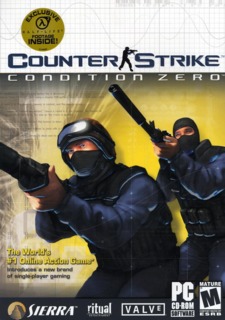Counter-Strike: Condition Zero
The missions are built around revamped maps from version 1.6 of Counter-Strike, as well as from newly designed scenarios. You select a team from a roster of bots, allocating points gathered from victorious rounds to “buy” more skilled allies. The primary objectives are taken straight from classic CS multiplay: different levels require you to defuse a planted bomb, rescue several hostages, escort a VIP to an extraction point, or kill all of the terrorists.
Initially, I was skeptical of how the bots would compare to human players; thankfully, they play very much like actual humans, and each displays a distinct personality.
For example, each bot has a unique rating for bravery, skill, and cooperation, so some will rush happily toward the opposing team while others prefer to stay back and provide “security.” Whenever I issued a command via the game’s hotkey-activated communication system, each bot would reply with a confirmation or denial of my order. Bots have an enormous database of scripted comments that are voiced throughout each round: hearing a teammate congratulate a kill by saying “Great shot!” or exclaim “Yes!” at the end of a victorious round gives the solo-but-like-multiplayer experience much more credibility.
As you progress through the tiers and unlock new levels (three levels on each of the six tiers), the skills of both the Terrorists and your teammates dramatically increase. Bots cautiously look around each room, walk to avoid being detected, and listen for footsteps. They even call out the location of enemies with lingo straight out of the multiplayer community, so you’ll know what it means when you hear “T’s rushing the middle through double doors.”
In addition, rounds can be completed only if you meet specific tasks, all meant to improve your skill and diversify the gameplay. The earlier tiers require you to eliminate enemies using specific weapons or rescue a set number of hostages, but later challenges call for multiple headshot kills or killing someone only after blinding them. I liked that these tasks not only helped improve my skills, but forced me to use some of the less obvious weapons in the game, such as the P228 pistol or the Scout sniper rifle — challenges I found to be great fun. The tiers can be completed pretty quickly — familiar maps took around five minutes each to beat, while new maps took at most 10 minutes — but the game also includes another single-player campaign from an earlier, abandoned version of Condition Zero, aptly labeled “Deleted Scenes.” These are completely linear missions where teamwork is scarce, the enemies just stand around, and the objectives are drab. These scenarios would be unacceptable if they made up the full game, but it’s interesting to see how the game could’ve turned out.
Underlying all the advances made in bot technology and the updated maps, Condition Zero is still fundamentally a five-year-old game. Location-specific damage and round-based teamplay are no longer innovative features, but this standalone package should satisfy both the Counter-Strike–curious and the broadband-impaired.

